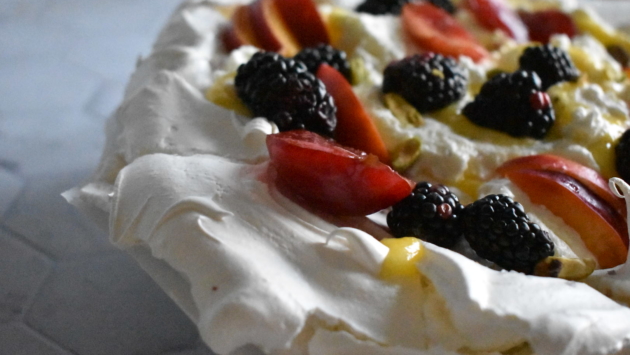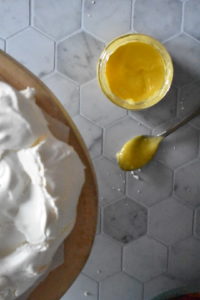
Ingredients:
For the Pavlova
6 egg whites (at room temperature)
pinch of cream of tartar
1½ cups granulated sugar
For the Vegan Aquafaba Pavlova
liquid from one 15-ounce can of unsalted or low sodium chickpeas, chilled
1 cup sugar
1 tablespoon arrowroot powder
pinch fine grain sea salt
1 teaspoon pure vanilla extract
1 teaspoon apple cider vinegar
For the Whipped Cream
2 cups heavy cream
2 tablespoons powdered sugar
1 teaspoon vanilla extract
For the Lemon Curd
4 large egg yolks (don’t waste those yolks!)
2/3 cup granulated sugar
1 tablespoon lemon zest (about 1 lemon)
1/3 cup fresh lemon juice (about 3 lemons)
1/8 teaspoon salt
6 tablespoons unsalted butter, softened to room temperature
Garnish
Seasonal fresh fruit
Directions:
Make the pavlova: Preheat the oven to 250°F. Line a baking sheet with parchment paper and draw a 9-inch circle in the middle (you can trace cake pans or anything else about the same diameter). Spray lightly with non-stick cooking spray.
Using an electric mixer with the whisk attachment, beat the egg whites on medium speed until frothy, then add the cream of tartar. Increase the mixer speed to medium-high and beat to soft peaks. While continuing to beat the egg whites, gradually add the granulated sugar (roughly 3 tablespoons at a time) and beat until glossy and stiff peaks form. Spoon the mixture onto the circle, and use a spatula to shape the egg white mixture into a circle with decorative sides, if desired.
 Bake for 1 hour, or until firm to the touch. Turn off the oven and prop the oven door open with a wooden spoon. Allow the pavlova to cool completely in the oven.
Bake for 1 hour, or until firm to the touch. Turn off the oven and prop the oven door open with a wooden spoon. Allow the pavlova to cool completely in the oven.
Make the whipped cream: Place the heavy cream, sugar, and vanilla extract in a large bowl and beat on medium-high speed until it holds stiff peaks.
Make the lemon curd: Fill the bottom pot of a double boiler with 1-2 inches of water. Place on high heat. Once the water begins to boil, reduce to low heat to keep the water at a simmer.
Place egg yolks, granulated sugar, lemon zest, lemon juice, and salt into the top pot of the double boiler. Using a silicone whisk, whisk until completely blended, then continue to whisk as the curd cooks. Constant whisking prevents the egg yolks from curdling. Whisk and cook until the mixture becomes thick, resembling the texture of hollandaise sauce, about 10 minutes. If curd isn’t thickening, turn up the heat and constantly whisk.
Remove pan from heat. Cut the butter into 6 separate pieces, then whisk into the curd. The butter will melt from the heat of the curd. Pour curd into a jar or bowl and allow to cool, then refrigerate.
Assembly: Transfer the pavlova to a serving platter, then top with the lemon curd, whipped cream, and fresh fruit. Serve immediately or refrigerate for up to 4 hours.
For vegan pavlova with aquafaba: Preheat the oven to 275°F. In a small bowl, mix together the sugar, arrowroot powder and salt. Set aside. Pour the chickpea liquid (aquafaba) into electric mixer. Beat at low speed, then slowly increase the speed to high. Beat for 5 minutes, until soft peaks have formed and the mixture has become very light and fluffy (it should expand to more than quadruple in size). Turn the speed down to medium-high and start adding the sugar gradually, one heaping tablespoon at a time.
Once all of the sugar has been added, increase the speed back to the highest setting. Continue to whip until stiff, glossy peaks form and hold their shape (about 3 minutes). You should be able to hold the mixing bowl upside down and have the meringue stay in place. Stop the mixer and add the vanilla and vinegar. Beat for another 10-15 seconds until incorporated.
Spoon the mixture onto the circle, and use a spatula to shape the mixture into a circle with decorative sides, if desired. Put the pavlova in the oven to bake and immediately turn down the heat to 250°F, and bake for 2 – 2.5 hours, or until the outside is dry to the touch and ever so slightly browned. The pavlova should sound hollow when very lightly tapped. Turn off the oven, leaving the pavlova inside to cool completely. Coconut cream can be used as a whipped cream substitute.